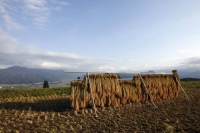A high of 38 degrees Celsius in Yamanashi Prefecture in July. A daily low of 31.4 C in Itoigawa, Niigata Prefecture, in August. A 27-degree day in Tokyo in November.
2023 was marked by intense, unrelenting heat across much of the world, including in Japan, where all-time temperature records seemed to fall weekly throughout the summer and well into autumn.
2024 may well end up worse.
Record February temperatures — including highs of between 18 and 20 C this past week across much of Japan, including northern areas — are a foreboding development in a year that experts say is likely to be the hottest in Japan’s history.
While scientists cannot pinpoint exactly how much of the record-breaking temperatures can be attributed to various natural and human-made causes, global warming and the El Nino climate phenomenon are both major factors.
“Our prediction systems tell us that El Nino will lessen starting this spring and disappear by the end of summer,” says Takeshi Doi, a senior climate researcher at Japan Agency for Marine-Earth Science and Technology (JAMSTEC). “But the remaining energy of El Nino still needs to dissipate — all the heat that has built up (over the course of El Nino) is still there.”
The European Climate Monitor reported that new global temperature records were set every month between June 2023 and January 2024. In Japan, spring, summer and fall all brought above-average temperature anomalies of 1.6, 1.8 and 1.4 C across the nation, according to the Meteorological Agency.
Scientific projections suggest that the natural phenomenon of El Nino is going to dovetail with higher average temperatures under climate change this spring, resulting in everything from heavy, wet snow that can damage infrastructure to an unpredictable arrival for the country’s signature cherry blossoms. Poor harvests and strained municipal budgets as cities in cooler regions race to install air conditioning units in public buildings could also result.
El Nino, a climate pattern where the equatorial Pacific Ocean becomes unusually warm, occurs every two to seven years. It typically brings higher water and surface temperatures to Japan, and often exerts its biggest influence on the country’s climate after it ends. That’s because the remaining energy of El Nino dissipates in the Indian Ocean, which brings monsoons to Japan during the rainy season.
“The Indian Ocean will be hotter this spring and summer, which will stimulate the rainy season,” explains Doi. “We need to be very careful about an unusually powerful rainy season and a warm spring, as the air heat effect will be at its peak this spring.”
El Nino is a natural phenomenon. Although it can cause some unusually hot or rainy summers, it wouldn’t be much of a concern if it wasn’t coupled with climate change, Doi says.
“With global warming (and El Nino) in the background, incidental or random patterns can lead to major damage,” he says. When the baseline is nearly 2 C higher — as the average temperatures in many Japanese localities were in 2023 compared with historical averages — an unusually hot or rainy day becomes a historically hot or rainy one.
Hokkaido not unscathed
These weather events played out from spring to winter over the last year, providing important warnings of what it might be like during potentially record-shattering heat in 2024.
Even Hokkaido couldn’t escape the heat in 2023. Over the course of just one week of a scorching summer, the Yomiuri Shimbun reported that 935 people were hospitalized for heatstroke in the prefecture and over 125 schools were shut down on Aug. 24.
High temperatures across the prefecture led Sapporo Mayor Katsuhiro Akimoto to announce the installation of air conditioning units in hundreds of schools at the end of last summer. With an installation rate of just 16.5% as of this year, the city is attempting to take rapid action to prevent illness and death from heatstroke — but it will reportedly take until 2027 to complete all the installations.
However, rising energy costs and persistent poverty among Japan’s elderly population and lower income households mean that having air conditioning installed doesn’t guarantee that people will actually be protected from dangerously high temperatures. Takanori Fujita at Hotto Plus, a nonprofit that works with economically vulnerable populations, says that the single most frequent consultation that they received from clients last year was about not being able to use air conditioners.
“They can’t use their AC because of the cost, and they can’t go to the hospital to get treatment because of the cost,” Fujita says. “Twenty years ago when I started this work, we never received these consultations. And while the government provides energy subsidies and aid to repair and install air conditioning to those who need it, the people who are most in need of these subsidies don’t receive them.” Fujita explains that poor publicity and a lingering stigma around getting government support are the main causes.
“We even get consultations from hospitals asking what to do about people who collapsed from heatstroke and ended up hospitalized without any way to pay,” he says.
In snowy climes, warmer weather can pose its own dangers. Kazuki Nakamura at the government’s Snow and Ice Disaster Prevention Research Center explains that they have observed an increase in the distribution of heavy, wet snow over the last decade — the exact type of snow likely to cause infrastructural and natural disasters.
“Disasters caused by heavy, wet snow have increased in recent years, resulting in people getting trapped on roads, power outages due to falling trees and injuries from cleaning snowy roofs,” says Nakamura.
Warming temperatures haven’t affected all snowfall equally. While heavier snow continues to fall thick in the mountains, more southern and low-altitude snow tourism destinations have suffered the brunt of warming.
“We’ve heard from resort patrollers that ski resorts in Honshu are having a hard time opening due to lack of snow at the beginning of the season,” Nakamura reports.
Food sources at risk
Hotter temperatures have also posed strange and unpredictable risks to wildlife and agriculture.
Seaside localities around Japan have confirmed first-time residents in their waters: tropical bottlenose dolphins. Along with warmer water temperatures, these dolphins have migrated further north. After some dolphins died last year from injuries due to ship propellers, it’s clear that they also require newfound caution among fishers.
A representative from the Fisheries Technologies Center lab at Osaka Prefecture’s Research Institute of Environment says they have confirmed new species of dolphins and sperm whales are active in Osaka Bay, along with other more southerly fish species, such as the tenjikutachi (cardinalfish). After two consecutive years of whales dying and washing up on the local shore, activists and researchers are searching for answers for this increased activity.
The presence of new species in local waters is also raising questions for the fishing industry.
“As the species caught in Osaka Bay change significantly in the future, it could lead to different seafood being consumed around Osaka and the eventual loss of traditional food culture,” the representative says. While the lab hasn’t observed any direct impacts of El Nino, it has confirmed higher temperatures in the bay, and is concerned about the growing presence of toxic plankton from more southerly waters.
At the same time, local farmers and farming cooperatives are hurrying to try to prepare their crops for a summer of brutal temperatures. In Otsu, Shiga Prefecture, more than a month of days with temperatures of 35 C or higher had lasting effects on the city’s rice crops. High night temperatures caused a proliferation of cloudy white grains that failed to accumulate enough starch.
“Harvest volumes decreased by 10% to 20% among farmers who hadn’t implemented heat-resistance measures,” says Takayuki Tsukamoto from the prefecture’s Mirai Agriculture Promotion Division. “On top of that, the proportion of top-grade rice (among nonheat-resistant rice) fell from 54.3% to 43.5%.”
Tsukamoto adds that soybean crops were also negatively affected.
Declines in harvest yields threaten local specialties as well, such as the “Zunda mochi” in Kakuda, Miyagi Prefecture, which is made with a special variety of green beans. The Green Five Edano agricultural cooperative reported losing more than half of these pods before they could even harvest this past year due to the heat.
Scientific solutions
But those affected the most by the heat aren’t taking it lying down.
Nakamura says his division is at work in ski resort boomtown Niseko conducting research to prevent avalanches and quantify the quality of powder snow to help ski resorts adapt.
On the coast, given severe seaweed shortages caused by higher water temperatures, the Fisheries Technology Center is researching seaweed strains that are more heat resistant. They’re also working on methods to detect the more southern toxic sea plankton species.
Meanwhile, Shiga Prefecture is heavily promoting their new kiramizuki white rice strain, which is organic, heat-resistant, less vulnerable to typhoon winds and rains, gentle on the soil and yields nearly 90% top-grade rice to boot.
“There was some resistance to the new strain at first, but because of how good it is for the environment, a number of farmers have embraced it,” Tsukamoto says.
The rice, typically only available in Shiga, made its Tokyo debut at Ginza’s Mitsukoshi department store earlier this month.
'Double-punch'
Forecasting this year's weather in light of global warming and El Nino is proving to be a difficult task. Data from Berkeley Earth suggests that human-caused global warming, the El Nino cycle, the solar cycle, 2022's Hunga Tonga eruption and reduction in marine fuel pollution have all contributed on various levels to the rising temperatures of the last decade.
"Even El Nino — the usual suspect behind record warm years — does not clearly explain 2023 temperatures," writes Zeke Hausfather for The Climate Brink. "2023 was so exceptionally warm that it suggests that this El Nino might be behaving differently."
Still, a coalition of major climate models all forecast 2024 as more likely than not to be warmer than 2023.
But Hausfather and others emphasize that individual years aren't as important as the long-term upward trend in temperatures driven by greenhouse gas emissions.
“So long as the CO2 emissions do not stop, we can assume the summer heat will continue to increase,” Doi says. “This year, the various stresses of climate change will create a double-punch along with El Nino and when natural change layers on top of the rising temperature, it can feel quite extreme.”





















With your current subscription plan you can comment on stories. However, before writing your first comment, please create a display name in the Profile section of your subscriber account page.